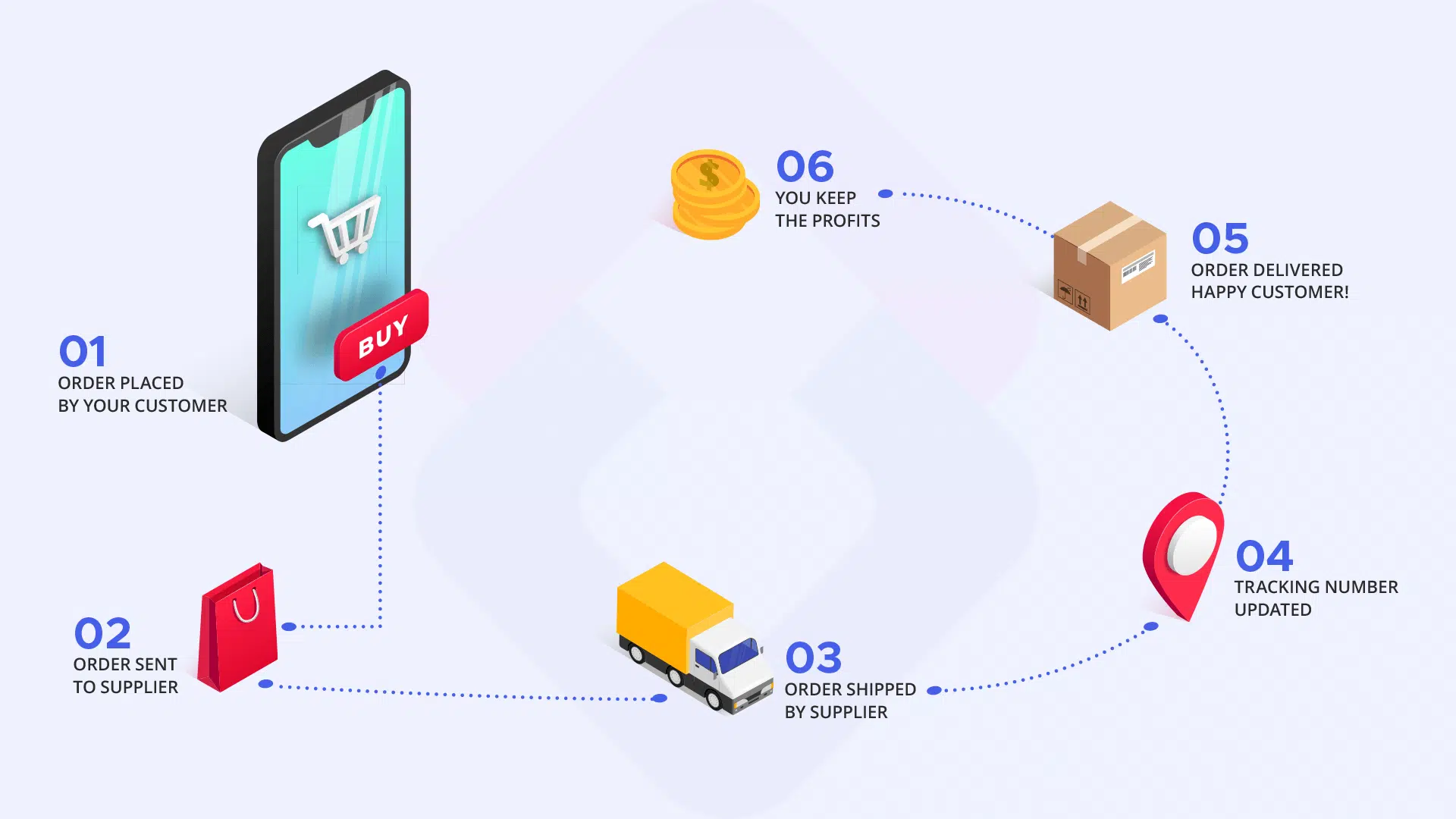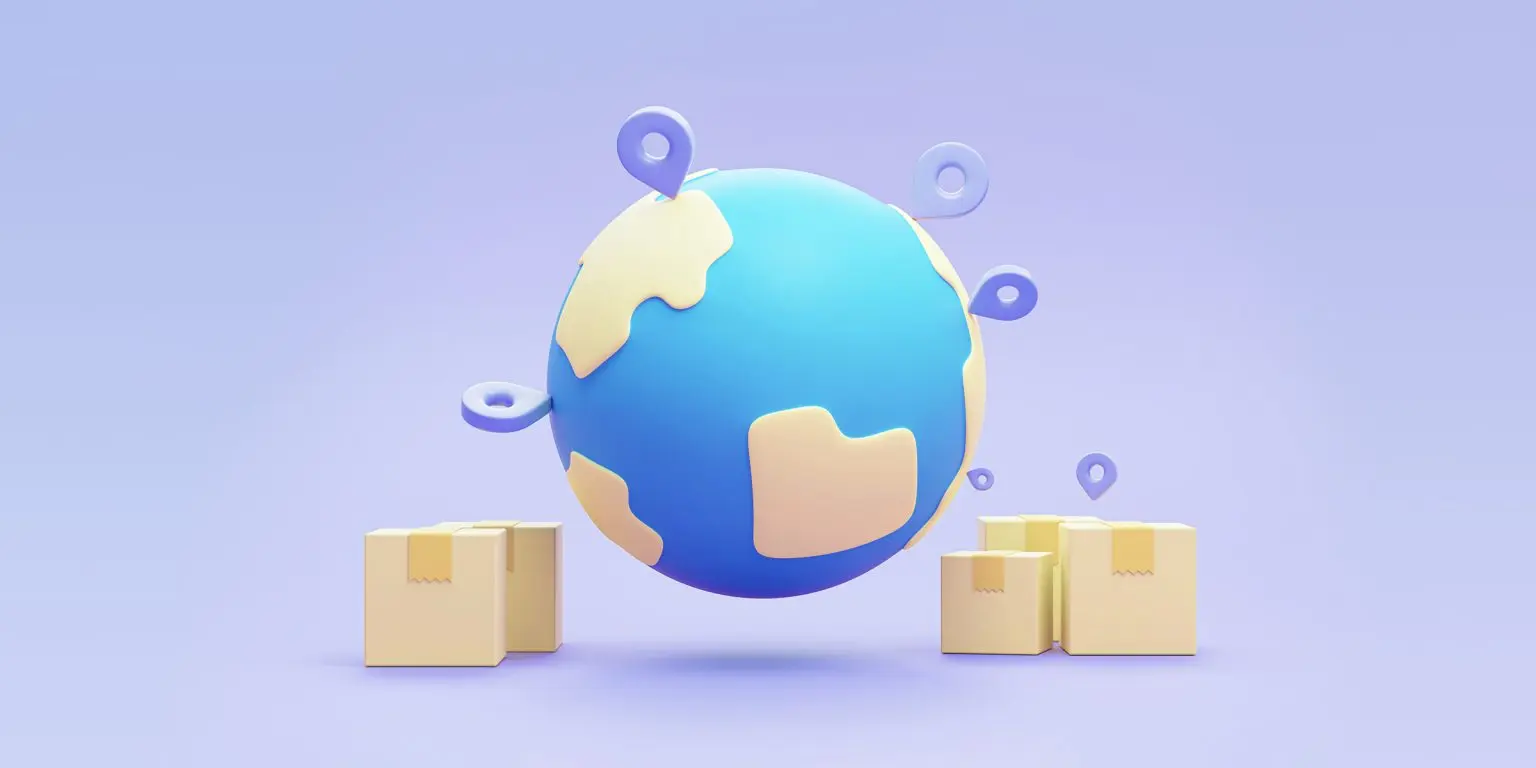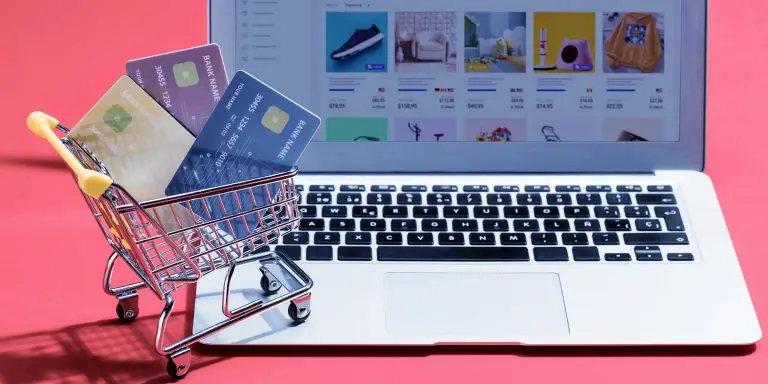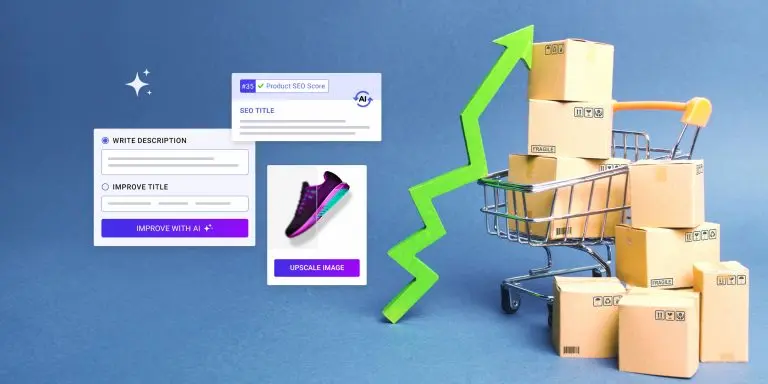Are you looking to start a business without managing inventory or dealing with logistics? Well, you’ve landed on the right page. Dropshipping has become one of the most popular ways for those wanting to break into the world of ecommerce.
We know it can all seem overwhelming now, so we thought of writing this next “Dropshipping for Dummies” guide. This is designed to simplify the entire process for you, making it easy to understand and apply.
Below, we’ll cover the basics of what dropshipping is, how it works, whether it is legal and profitable and the essential steps you need to take to launch your own dropshipping business.
By the end, you’ll have a clear roadmap to get started and avoid common challenges that many new dropshippers face.
Table of Contents
What is dropshipping?
At its core, dropshipping is a retail fulfillment method where a store doesn’t keep the products it sells in stock. Instead, when a customer makes a purchase, the store owner (you) buys the product from a third-party supplier. The supplier then ships the product directly to the customer. As a result, the store owner doesn’t need to handle the product directly or manage inventory.
Here’s a simple breakdown of how dropshipping works:
- A customer places an order on your online store.
- You pass the order details to a supplier (usually through an automated system, and that’s where AppScenic comes).
- The supplier ships the product directly to the customer.

You make a profit from the difference between the price you charge the customer and the cost of the product from the supplier.
Why choose dropshipping?
Dropshipping offers several compelling advantages that make it an attractive business model, especially for aspiring entrepreneurs who are looking for a low-risk way to get started. Here’s why dropshipping could be the perfect fit for you:
1. Low startup costs
One of the most significant benefits of dropshipping is the low initial investment. You don’t need to buy inventory upfront, which saves you from the huge costs associated with purchasing products in bulk, warehousing, and inventory management. This means you can launch your store without having to worry about large capital expenditures.
Plus, by avoiding the risks of unsold stock, you can allocate your funds toward marketing and scaling your business instead. Because, contrary to popular belief, you will need to invest some money when starting dropshipping.
3. No need for storage or logistics
With dropshipping, you never have to worry about the logistics of storing, packaging, or shipping products. Once a customer places an order, the supplier takes care of everything, from shipping to fulfillment.
This frees up your time to focus on essential aspects of the business, like marketing, customer service, and finding new product opportunities. It also eliminates the hassle and costs associated with maintaining a physical warehouse.
2. Flexible location
Dropshipping provides the ultimate flexibility in terms of where you run your business. All you need is a laptop and an internet connection, allowing you to manage your store from anywhere in the world.
Whether you’re a digital nomad or just want the freedom to work from home, dropshipping offers location independence, making it an excellent choice for those who value mobility and freedom.
4. Wide product selection
Since you’re not investing in inventory, you can offer a wide range of products without the financial risk. Dropshipping allows you to test various products and niches without worrying about unsold stock piling up.
This flexibility not only helps you cater to diverse customer preferences but also gives you the ability to adapt quickly to market trends and expand your product offerings as needed.
Is dropshipping legal?
Yes, dropshipping is legal! While owning and managing a dropshipping business is indeed legal, there are important legal considerations you need to know before starting. Like any other ecommerce business, dropshipping operates under specific laws and regulations, and it’s your responsibility to ensure compliance.
To start, you’ll want to research and understand the ecommerce laws that apply to the country or countries where you plan to operate. Each country has its own set of rules concerning online selling, product liabilities, consumer protections, and taxation. For example, the European Union has strict consumer protection laws, while US regulations emphasize data privacy and product safety standards. Ignoring these can lead to hefty fines or even force you to shut down your business.
Beyond national laws, you should also:
- Check your supplier’s legal standing: Ensure they are legitimate and are not violating any intellectual property laws by selling counterfeit goods. Partnering with untrustworthy suppliers can get you into legal trouble.
- Consider consumer rights: Be clear about refund policies, shipping times, and customer service protocols to avoid legal disputes.
- Understand sales tax and VAT obligations: Depending on your location and where your customers reside, you may need to collect and remit taxes.
Before jumping in, be thorough in your research on common legal concerns specific to dropshipping in your target market. This way, you can avoid potential legal pitfalls and run your business smoothly.
For more detailed information on dropshipping legality, check out our guide to dropshipping legal risks and watch our video on the legal aspects of dropshipping in the US below.
Is dropshipping profitable?
Dropshipping can absolutely be a profitable business model, provided you choose the right products, maintain healthy profit margins, and effectively fulfill orders. But, like any other business, it requires dedication, strategic planning, and consistent effort to truly succeed.
Let’s look at the facts. According to a Grand View Research report, the global dropshipping market reached a staggering $225.99 billion in 2022. Even more impressive, the market is expected to grow at a rate of 23.4% from 2023 to 2030. Another study by Research and Markets estimates that the dropshipping industry will hit $591.77 billion by 2027. These figures clearly demonstrate the growing potential and profitability of this business model.
Moreover, 22-33% of online retailers have adopted dropshipping as their primary method of order fulfillment. On platforms like Amazon, third-party sellers that use dropshipping account for a whopping 61% of online sales. Meanwhile, Shopify, one of the most popular platforms for dropshipping, reported revenue of $7.764 billion for the twelve months ending June 2024—a 23.18% year-over-year increase. These numbers highlight the massive opportunity dropshipping offers to online entrepreneurs.
Read more: 30+ Dropshipping Statistics You Need to Know in 2024
What makes a dropshipping business profitable?
- Choosing the right products and niche: It’s essential to focus on products that have a proven demand, meaning people are actively searching for and buying these products.
- Targeted marketing efforts: Your ability to market effectively can make or break your dropshipping business. Choosing the right advertising channels is crucial.
- Choosing the right ecommerce platform: A user-friendly, easy-to-navigate website is vital to converting visitors into customers. We recommend using Shopify or WooCommerce.
- Reliable dropshipping suppliers: The suppliers you choose play a significant role in determining your success. Using a dropshipping platform like AppScenic gives you access to fast, reliable suppliers who offer a wide range of high-quality products.
- Top customer service: The importance of excellent customer service can’t be overstated. By treating your customers with respect, providing timely responses to their queries, and resolving issues promptly, you build a loyal customer base.
Read more about why dropshipping is such a strong and profitable business model in 2024 and beyond.
Key steps to start dropshipping
1. Choose a profitable niche
Before you can launch a successful dropshipping business, you need to decide what products to sell. This begins by selecting a niche, a specific category of products that appeal to a particular group of people. Picking a niche is crucial because it will influence your marketing efforts, your competition, and your potential profitability.
How to choose a niche:
- Identify a passion or interest: Running a business is hard work, so it’s easier if you’re passionate about the products you sell.
- Assess market demand: Use tools like Google Trends, Keyword Planner, Facebook Audience Insights, and even Shopify Analytics, or competitor analysis. All these tools can help identify trends and potential winning products. Selling products that already have demand reduces the risk of wasted time and money on unprofitable items.
- Consider profit margins: Make sure there’s enough markup between the product cost and what you can charge your customers. Typically, high-ticket products that retail for $100-$200 provide a healthy margin for profit.
2. Find reliable suppliers
A reliable supplier is the backbone of your dropshipping business. Your supplier will handle inventory, shipping, and returns, so you need one that is trustworthy and efficient. There are a few ways to find suppliers:
- Dropshipping platforms: Websites like AppScenic make it easy to find vetted suppliers. Our dropshipping platform, for example, gives you access to fast, reliable suppliers who offer a wide range of high-quality products. Working with trustworthy suppliers ensures that your customers receive their products on time and in good condition, which helps maintain a positive customer experience and reduces return rates.
- Direct supplier outreach: You can contact manufacturers directly to see if they offer dropshipping services.
- Wholesale directories: Use directories to find legitimate wholesalers who provide dropshipping services.
When choosing a supplier, consider:
- Shipping times: Fast shipping is key to customer satisfaction. Choose suppliers with short shipping times, especially if they are overseas.
- Product quality: Ask for product samples to test quality before selling. This ensures your customers receive high-quality goods.
- Customer service: A supplier with poor customer service can hurt your business reputation. Make sure your supplier is easy to communicate with and responds quickly to any issues.
Read more: How to Identify a Reliable Supplier for Your Dropshipping Niche
3. Set up your online store
Once you’ve chosen your niche and suppliers, it’s time to set up your online store. There are many platforms available, but Shopify is the most popular for dropshipping because of its ease of use and integration with dropshipping apps like AppScenic.
Platforms like Shopify or WooCommerce offer customizable templates and features designed to simplify the process of building and managing an online store. A professional-looking website can increase your store’s credibility and trustworthiness, ultimately leading to more sales.
Setting up your store:
- Choose a domain name: Pick a name that reflects your niche and brand identity.
- Design your store: Use Shopify’s drag-and-drop builder to create a professional-looking store. Choose themes that are easy to navigate and visually appealing.
- Install apps: Shopify has apps that allow you to automate the process of adding products from suppliers and fulfilling orders.
4. Add products and optimize listings
Now that your store is set up, it’s time to add products. When adding products to your store, focus on optimizing product descriptions and images. If you use AppScenic our AI-powered tool, Description & Images, can help you create compelling and high-converting product titles and descriptions plus enhance your images up to 4 times their original resolution.
Tips for product listings:
- High-quality images: Visuals sell. Use high-resolution images that show your product from multiple angles.
- Compelling descriptions: Write product descriptions that highlight the benefits of the product, not just the features. Use persuasive language that makes customers want to buy.
- Pricing strategy: Set competitive pricing. Remember to factor in shipping costs and your desired profit margin.
5. Drive traffic to your store
No matter how great your store looks, it won’t succeed without traffic. You need to attract potential customers to your website. Here are a few methods to drive traffic:
- Social media marketing: Platforms like Facebook, Instagram, and TikTok are excellent for promoting products. You can run paid ads to target specific demographics or use organic posts to engage your audience.
- Influencer marketing: Partner with influencers in your niche to promote your products. This is a powerful way to build trust and expand your reach.
- Search engine optimization (SEO): Optimize your product pages for search engines. This includes using relevant keywords in product descriptions, titles, and meta tags.
- Google Ads: Paid search ads can drive highly targeted traffic to your store, especially when you bid on buying-intent keywords.
Pro tip: For example, while some products might thrive on Google Ads, others may perform better on Facebook or TikTok. As a beginner, it’s essential not to spread your marketing budget too thin across multiple platforms. Instead, start with a single channel, optimize your campaigns, and then scale.
6. Focus on customer service
Providing excellent customer service is essential for long-term success in dropshipping. Since you don’t have control over fulfillment, resolving customer issues quickly can make or break your business.
Tips for great customer service:
- Quick response times: Answer customer inquiries as fast as possible. If an issue arises with an order, keep the customer informed every step of the way.
- Clear return policy: Make sure your return policy is easy to understand and clearly displayed on your website.
- Build trust: Offer guarantees, display customer reviews, and be transparent about shipping times.
Happy customers are more likely to leave positive reviews and recommend your store to others, which can lead to repeat business and organic growth.
Common challenges in dropshipping
While dropshipping is a great business model for beginners, it’s not without challenges. Here are some common hurdles you might face and how to overcome them:
- Low profit margins: Dropshipping typically has slimmer profit margins than traditional retail. You need to sell a higher volume of products to make substantial profits. Focus on upselling, bundling products, and increasing average order value.
- Shipping times: Long shipping times from overseas suppliers can lead to customer dissatisfaction. To mitigate this, choose suppliers that offer faster shipping or consider working with local suppliers.
- High competition: Since dropshipping has low barriers to entry, you’ll face stiff competition. Make sure to differentiate your store by offering excellent customer service, creating unique branding, and providing value through content.
Do I need to register my business for dropshipping?
The short answer is yes, you do need to register your business before you start dropshipping. Even though dropshipping seems like a relatively simple business model, there are legal requirements you must meet to ensure you’re running a legitimate operation.
Before setting up your online store, it’s important to understand the legal obligations in your region and determine what type of business structure best suits your needs.
Why register your business?
To legally sell products, receive payments, and pay taxes, your dropshipping business needs to be officially registered. Business registration legitimizes your operation and ensures compliance with local, state, or national regulations. Without registering, you risk facing penalties, difficulties opening a business bank account, or complications with payment processors.
Business structures for dropshipping
Here are a few common business structures for dropshippers:
- Sole Proprietorship (Sole Trader in the UK): This is the most straightforward option for many dropshippers. However, the downside is that you’re personally liable for any debts or legal issues related to your business.
- Limited Liability Company (LLC, or LTD in the UK): An LLC provides more protection by separating your personal assets from your business liabilities. This structure is highly recommended for most dropshippers who want to limit personal risk while still maintaining a simple setup.
- Corporation (C-corp): If you’re looking to scale your business significantly or attract investors, setting up a C-corp might be a better option. However, this structure involves more formalities and higher costs.
Regional considerations
Where you dropship also matters. Business registration requirements differ from country to country, and it’s essential to follow local rules to remain compliant. For instance:
- In the USA: You may need an Employer Identification Number (EIN) for tax purposes, even if you’re a sole proprietor. You’ll also want to check your state’s requirements for business licenses.
- In the UK: If you’re trading as a sole trader or registering as an LTD, ensure you’re following the necessary steps for registration with HMRC and Companies House. Depending on your revenue, you may also need to register for VAT. Check out our guide on how to start a dropshipping business in the UK.
Look for professional advice
Because there are so many variables involved, consulting a legal professional or accountant is a wise move when deciding how to structure and register your dropshipping business. They can provide tailored advice based on your specific situation and ensure you meet all legal obligations.
In conclusion, registering your business is a crucial step in establishing a legitimate and compliant dropshipping store. It’s a small but important investment in the long-term success of your eCommerce venture.
How much does it actually cost to start dropshipping?
There are plenty of “experts” out there claiming you can start a dropshipping business for under $100 or even for free. While it’s technically possible to create an online store with a minimal budget, the reality is quite different if you’re aiming for a competitive, fully functional business that can actually generate orders and sales.
While one of the biggest advantages of dropshipping is that you don’t need to pay for inventory upfront, you’ll still need to invest in essential aspects like building your online store, finding suppliers, and marketing your products. These are non-negotiables if you want to stand out and attract customers.
Here’s a breakdown of where most of your startup budget will go when starting a dropshipping business:
1. Building your online store
Domain name: Approximately $15 per year.
Ecommerce platform: Shopify charges $39 per month for its basic plan, plus a 2% transaction fee on sales unless you use Shopify Payments.
Other apps: Depending on your needs, you may need apps to help with SEO, email marketing, or upselling, which can add an extra $60 per month to your costs.
2. Supplier Fees
Platforms like AppScenic, which offer access to high-quality suppliers, cost around $29 per month.
3. Product Samples
Sampling products typically costs around $200, depending on how many products you want to test.
4. Marketing Costs
You should expect to spend at least $1,000 per month on ads, especially during the early stages when you’re testing products and identifying your target audience.
5. Business Registration
In the USA, setting up an LLC can cost around $600 as a one-time fee, depending on your state. It’s important to consult with a legal expert to understand the specific requirements in your region.
6. Other Expenses
Don’t forget about other business expenses, such as obtaining a tax ID or necessary business licenses, depending on where you’re operating.

Breakdown of startup costs
Here’s a rough estimate of how much it can cost you to start a dropshipping business in the USA:
- Domain: $15 per year
- Ecommerce platform (Shopify): $39 per month (plus a 2% transaction fee)
- Dropshipping platform (AppScenic): $29 per month
- Sampling products: $200 (one-time cost)
- Marketing: $1,000 per month
- LLC company incorporation: $600 (one-time fee)
- Other apps: $60 per month
In total, the initial cost to get started could reach approximately $2,000. Once your store is up and running, you can expect monthly costs to be around $1,000, particularly if you scale back your advertising budget.
However, the total startup cost can vary depending on factors like your niche, how many products you want to test, the LLC registration process in your state, and the dropshipping platform you choose.
Conclusion
As said, dropshipping is an accessible and scalable way to start an ecommerce business. With low upfront costs and the ability to automate much of the business, it’s an ideal model for beginners looking for a flexible side hustle. However, success in dropshipping requires careful planning, dedication, and the ability to adapt to changing market conditions.
By following the steps outlined in this guide, you’ll have a solid foundation to start your dropshipping business, drive traffic to your store, and grow your online presence.
Now, it’s up to you to take action and turn your dropshipping dream into a profitable reality!











